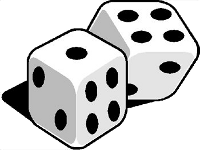Random numbers from entangled atoms
 Generating random numbers is difficult. Although tt's common practice to use pseudo-random algorithms to generate 'random' numbers for cryptographic keys, these algorithms do not produce truly random numbers because the results are deterministically dependent on the seed used.
Generating random numbers is difficult. Although tt's common practice to use pseudo-random algorithms to generate 'random' numbers for cryptographic keys, these algorithms do not produce truly random numbers because the results are deterministically dependent on the seed used.
For the most refined cryptographic purposes, randomness needs to come from an external source, as a result of combining non-predictable events or using special hardware. It is, however, impossible to determine with certainty from the generated values whether randomness produced using external factors is truly random.
True randomness can only be obtained using quantum effects. Even with quantum systems, it had until now not been possible to prove unequivocally that nothing had biased the results. Researchers at the University of Maryland / NIST Joint Quantum Institute working together with colleagues in Europe, have now developed a new approach to solving this problem. Quantum systems (such as photons or atoms) can be entangled. This means that their states are no longer independent. As soon as one of the two systems is measured, the second instantaneously acquires a value dependent on the first value (e.g. the same polarisation). Despite that the fact that they are separated in space, they behave as if they were coupled together. This quantum entanglement goes against everyday experience and can only be observed in microscopic quantum systems.
The researchers are now making use of the reverse conclusion – if two such systems are entangled, they must behave 'quantum mechanically' and cannot be controlled by external factors. This means that randomness generated from them cannot be externally influenced. The researchers captured two atoms in two completely isolated traps spaced one meter apart and used photon emissions to entangle them. As soon as both atoms emit a photon simultaneously, they are assumed to be entangled. The researchers checked this using Bell inequalities, which are always violated where the laws of classical physics no longer apply. Both atoms were then randomly rotated and measurements of emitted photons taken. If the inequalities were violated, a random bit was generated from the measured photons.
This process allowed the researchers to generate 42 genuinely random bits from 3,000 measurements with a 99% confidence level. The system is currently much too slow and complicated for practical use, but it is the physical principle that is important in such experiments, not the specific process used.
The project was part-funded to the tune of €9 million from the European Research Council's PERCENT (percolating entanglement and quantum information resources through quantum networks) and QORE (quantum correlations) projects. The complete research has been published in Nature magazine. (Reinhard Wobst)
(Reinhard Wobst / crve)








![Kernel Log: Coming in 3.10 (Part 3) [--] Infrastructure](/imgs/43/1/0/4/2/6/7/2/comingin310_4_kicker-4977194bfb0de0d7.png)

![Kernel Log: Coming in 3.10 (Part 3) [--] Infrastructure](/imgs/43/1/0/4/2/3/2/3/comingin310_3_kicker-151cd7b9e9660f05.png)








